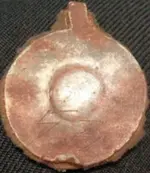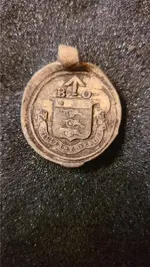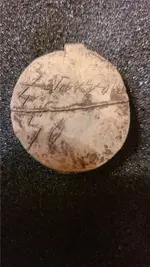You are using an out of date browser. It may not display this or other websites correctly.
You should upgrade or use an alternative browser.
You should upgrade or use an alternative browser.
War of 1812 British Military "Military Depot" lead Seal
- Thread starter SGTBilko
- Start date
- Joined
- Dec 23, 2019
- Messages
- 6,433
- Reaction score
- 20,465
- Golden Thread
- 0
- Location
- Surrey, UK
- Primary Interest:
- All Treasure Hunting
Cool find.
The ‘BO’ at the top stands for “Board of Ordnance” and the Board used the ‘broad arrow’ mark as an indication that an item was government property. The shield with three field pieces and three cannonballs above had been used as their armorial since the 17th Century but not given royal approval until 1806.
The Board had been responsible since Tudor times for supplying the British Army and Navy with gunpowder, munitions and fighting equipment including, ultimately, uniforms when they became standardised. Other items were supplied by various agencies including private contractors.
It is a ‘cloth seal’ and, as far as I know, wasn’t used for consignments of military equipment as such. It would have been applied to things like bolts of cloth and other textiles purchased for uniform-making and bales of finished uniform garments, in addition to any seals already applied, to protect the items as Crown property.
in 1806, the Board directed its storekeepers and others to mark "all descriptions of Ordnance Stores ... with the broad arrow as soon as they shall have been received as fit for His Majesty's Service". From 1822 the Board was given additional responsibility for sourcing, storing and supplying a variety of additional items for the Army, including tents, and other camp equipment including blankets, plus 'barrack stores'. From 1832 their remit was further expanded to food (including forage for cavalry regiments), coal and candles for all homeland troops. It ceased to exist as such under that name in 1855 after criticism of its performance during the Crimean War.
The markings will most probably relate to quantities and nature of the goods to which the seal was applied. Yours seems to have some numbers including ¾. Here’s the back side of another example (from after the Board was dissolved) and note that numbers and letters with curvature were habitually gouged in straight lines (53 here) simply because they were easier to scratch than curves.

The ‘BO’ at the top stands for “Board of Ordnance” and the Board used the ‘broad arrow’ mark as an indication that an item was government property. The shield with three field pieces and three cannonballs above had been used as their armorial since the 17th Century but not given royal approval until 1806.
The Board had been responsible since Tudor times for supplying the British Army and Navy with gunpowder, munitions and fighting equipment including, ultimately, uniforms when they became standardised. Other items were supplied by various agencies including private contractors.
It is a ‘cloth seal’ and, as far as I know, wasn’t used for consignments of military equipment as such. It would have been applied to things like bolts of cloth and other textiles purchased for uniform-making and bales of finished uniform garments, in addition to any seals already applied, to protect the items as Crown property.
in 1806, the Board directed its storekeepers and others to mark "all descriptions of Ordnance Stores ... with the broad arrow as soon as they shall have been received as fit for His Majesty's Service". From 1822 the Board was given additional responsibility for sourcing, storing and supplying a variety of additional items for the Army, including tents, and other camp equipment including blankets, plus 'barrack stores'. From 1832 their remit was further expanded to food (including forage for cavalry regiments), coal and candles for all homeland troops. It ceased to exist as such under that name in 1855 after criticism of its performance during the Crimean War.
The markings will most probably relate to quantities and nature of the goods to which the seal was applied. Yours seems to have some numbers including ¾. Here’s the back side of another example (from after the Board was dissolved) and note that numbers and letters with curvature were habitually gouged in straight lines (53 here) simply because they were easier to scratch than curves.

SGTBilko
Jr. Member
- #3
Thread Owner
Hey Red-Coat,
Thanks for the information and background, this helps tremendously. I knew it was a seal, but not sure of the scratches and what type of product it was attached to. I do see the numbers now which makes sense, and there is also some other writing as well which may be the type of material it was attached to? I own 10 acres of land where the British army had a fort and village near Canada during and after the war of 1812. I have found many of these seals along with clay pipes, military buttons, glass from bottles, parts from brown bess rifles, musket balls, rifle flint, pottery and lots of silver Indian trade jewelry. There is so much on my property I literally dug in one hole for over 3-4 hours. I have other items I cannot identify, that maybe you could help me with? Everything I am finding is pretty much British military and civilian.
I'd be happy to post more images if you think you could help identify some of my other finds.
Thanks again!
Thanks for the information and background, this helps tremendously. I knew it was a seal, but not sure of the scratches and what type of product it was attached to. I do see the numbers now which makes sense, and there is also some other writing as well which may be the type of material it was attached to? I own 10 acres of land where the British army had a fort and village near Canada during and after the war of 1812. I have found many of these seals along with clay pipes, military buttons, glass from bottles, parts from brown bess rifles, musket balls, rifle flint, pottery and lots of silver Indian trade jewelry. There is so much on my property I literally dug in one hole for over 3-4 hours. I have other items I cannot identify, that maybe you could help me with? Everything I am finding is pretty much British military and civilian.
I'd be happy to post more images if you think you could help identify some of my other finds.
Thanks again!
- Joined
- Dec 23, 2019
- Messages
- 6,433
- Reaction score
- 20,465
- Golden Thread
- 0
- Location
- Surrey, UK
- Primary Interest:
- All Treasure Hunting
Post away my friend. I'd like to see your finds. British colonial military history is my thing and, if I can't help, for sure there will be others that can.
SGTBilko
Jr. Member
- #5
Thread Owner
Sounds good! I have lots of plastic tote containers containing everything from old square nails, hinges and barrel straps up to Indian trade rings. I am trying to locate some information on maps of the fort and village that were sent back to England by the engineers. Any idea who or where I could connect with someone over in the UK that might have these maps where the village and house locations were? I'll send over some images of finds to get identified for you to look over. I had also found an indian trade medallion that only nine were known to exist in 2009. These were given to the indian chiefs by the British Gov't.
Thanks again, Red-Coat!
Thanks again, Red-Coat!
Similar threads
- Replies
- 3
- Views
- 659
Users who are viewing this thread
Total: 1 (members: 0, guests: 1)





